Olives and Olive Oil in Greece
Greece is famous all over the world for its olive oil and olives. In fact, in order to grow olives and then make olive oil, you need to work hard. Only those who have collected olives themselves can understand how difficult it is. In Greece, almost every family has at least one plantation of olive trees, so they, like no one else, know about this craft. In this article we will talk about all the details of oil production.
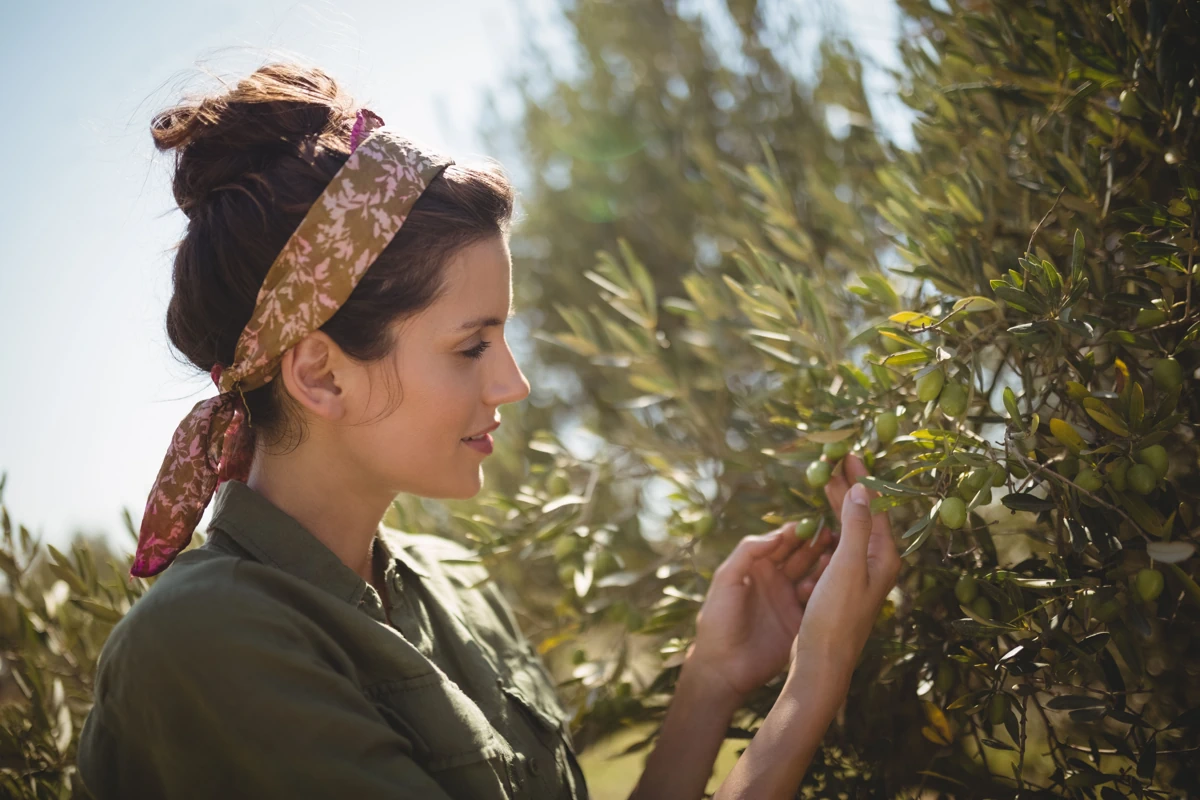 So it may seem strange but it all starts with a story. Almost all pieces of land with olive trees are inherited, there have been found olive trees couple thousands years old that still bear fruit even today. Let’s start with sorting the olives by varieties.
So it may seem strange but it all starts with a story. Almost all pieces of land with olive trees are inherited, there have been found olive trees couple thousands years old that still bear fruit even today. Let’s start with sorting the olives by varieties.
There are different varieties of olives that we eat: kalamon, koroneika, androcarpi, vasilakada, strogiloelia and others. They grow on tall trees with storng trunks and wide crowns, here comes the question: how to collect thise olives?
The olives that we eat practically “come” to the table by themselves. They should not be knocked down, because damaged olives can not be marinated. The process of collecting olives has several steps. In October, Greeks spread nets with fine weaving under the trees and wait for the olives to start falling, also farmers collect them from the nets from time to time. If the tree is still young and not tall, olives are collected by hands.
In October, Greeks spread nets with fine weaving under the trees and wait for the olives to start falling, also farmers collect them from the nets from time to time. If the tree is still young and not tall, olives are collected by hands.
The next stage is soaking – “xepicrisma”, which literally means the removal of bitterness. The collected olives are carefully sorted, damaged are thrown away, the rest are sent to a container with water for 2-3 weeks, the water must be changed every day. After that, they are poured with marinade for another 2 weeks. This is the most classic cooking recipe, but there are also many others.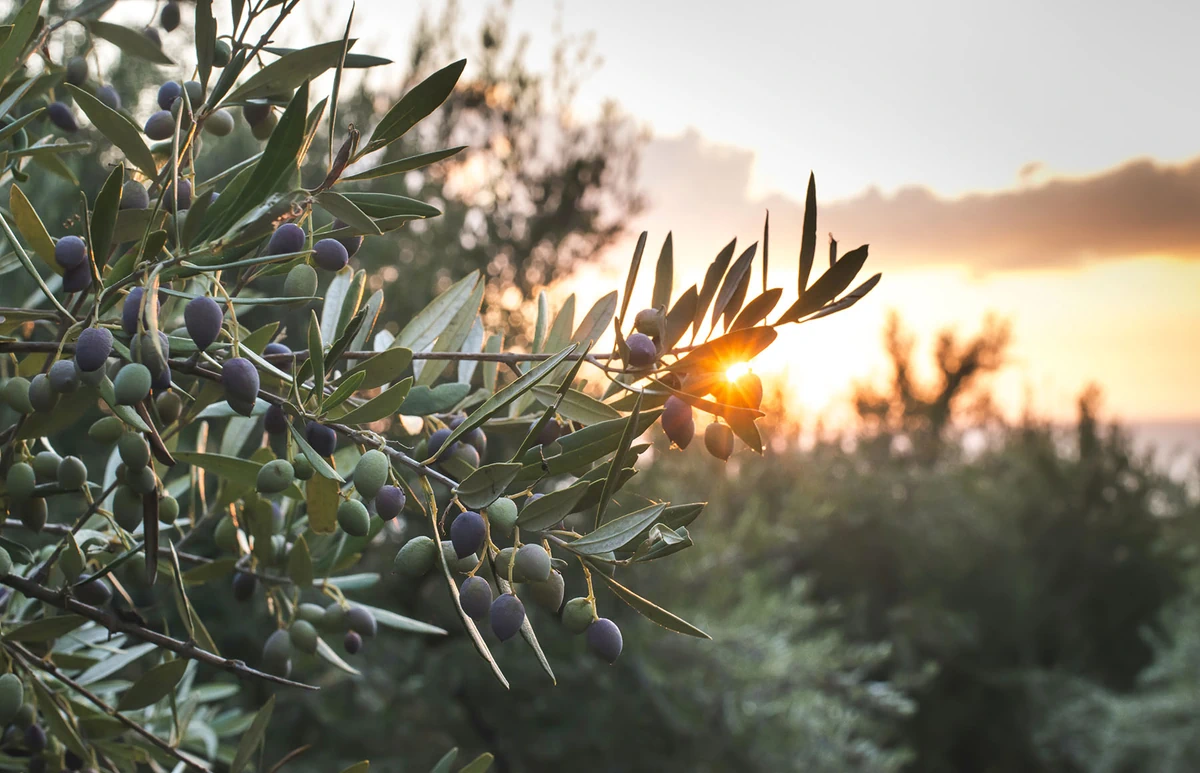 By the way, green olives, brown or black can be harvested from one tree, and the color differs in the degree of ripeness, also depending on this the time of marinating the olives can be different. It’s better to store olives in a dark cabinet, in a jar with olive oil and vinegar, you can add herbs or garlic. Not all olives that we eat are suitable for oil.
By the way, green olives, brown or black can be harvested from one tree, and the color differs in the degree of ripeness, also depending on this the time of marinating the olives can be different. It’s better to store olives in a dark cabinet, in a jar with olive oil and vinegar, you can add herbs or garlic. Not all olives that we eat are suitable for oil.
Now it’s time to talk about the “liquid gold”, the olive oil. If the olive trees whose olives we eat practically do not need any care, then the trees whose fruits are harvested for making olive oil, the care is very necessary. It all starts in early spring, when the trees are blooming, it is necessary to make sure that there is enough moisture, the tree has not been damaged by insect-pests, and the soil is loose enough.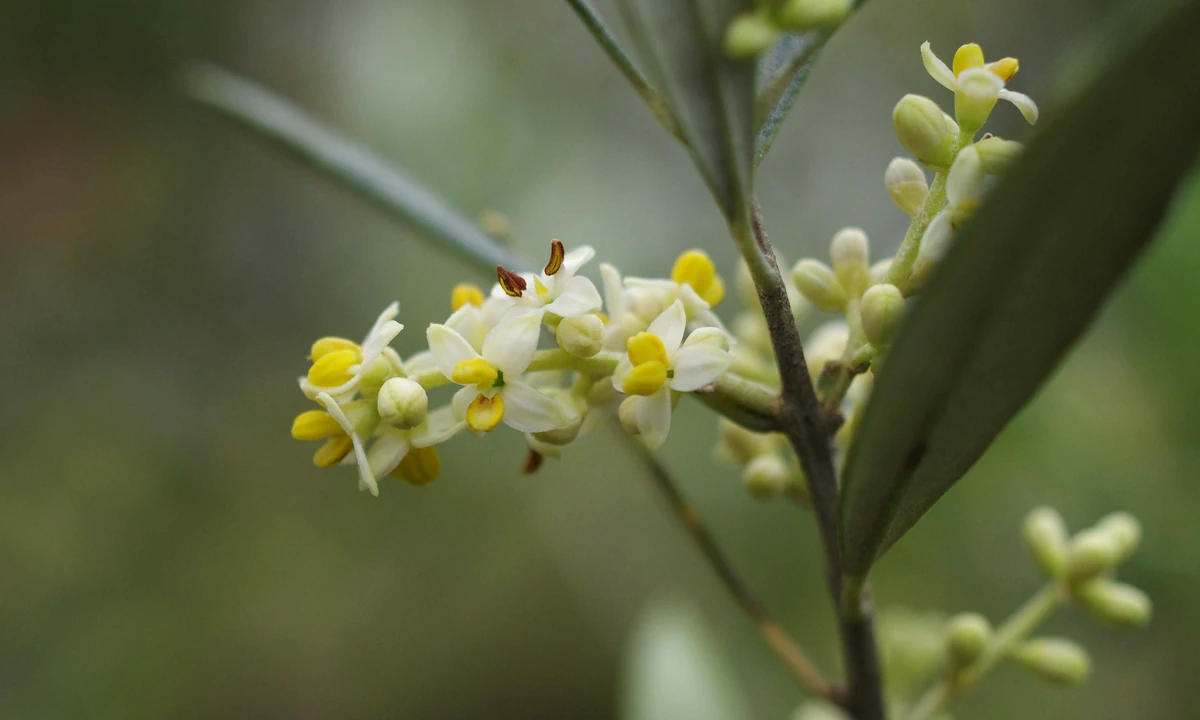 After blooming, when the fruits have already appeared, it is necessary to spray the trees from insect-pests, otherwise the harvest will be spoiled. It is known that olive trees can bear fruit without additional irrigation, but in some regions there is not enough rain for a good harvest, so it is necessary to additionally irrigate the trees.
After blooming, when the fruits have already appeared, it is necessary to spray the trees from insect-pests, otherwise the harvest will be spoiled. It is known that olive trees can bear fruit without additional irrigation, but in some regions there is not enough rain for a good harvest, so it is necessary to additionally irrigate the trees.
Fruits ripen at different times, depending on the region where the tree grows, on the variety of the tree itself and the amount of moisture. Usually from the beginning of October to the end of December, and often until January, olives are harvested. The highest quality oil is considered to be from unripe green or half purple olives.
Most of families collect olives on their own. Early in the morning, everyone goes to the plantation, usually the oldest member of the family remembers and marks their trees in the garden, since there are no fences and a neighbor’s garden begins right next to the trees. Usually in order to get to your garden, you need to go through the neighbor’s. The first thing to do is to spread nets under the trees, so that no fruit is lost during harvesting. Long three-meter sticks with rotating tips are connected to the generator and the collection begins.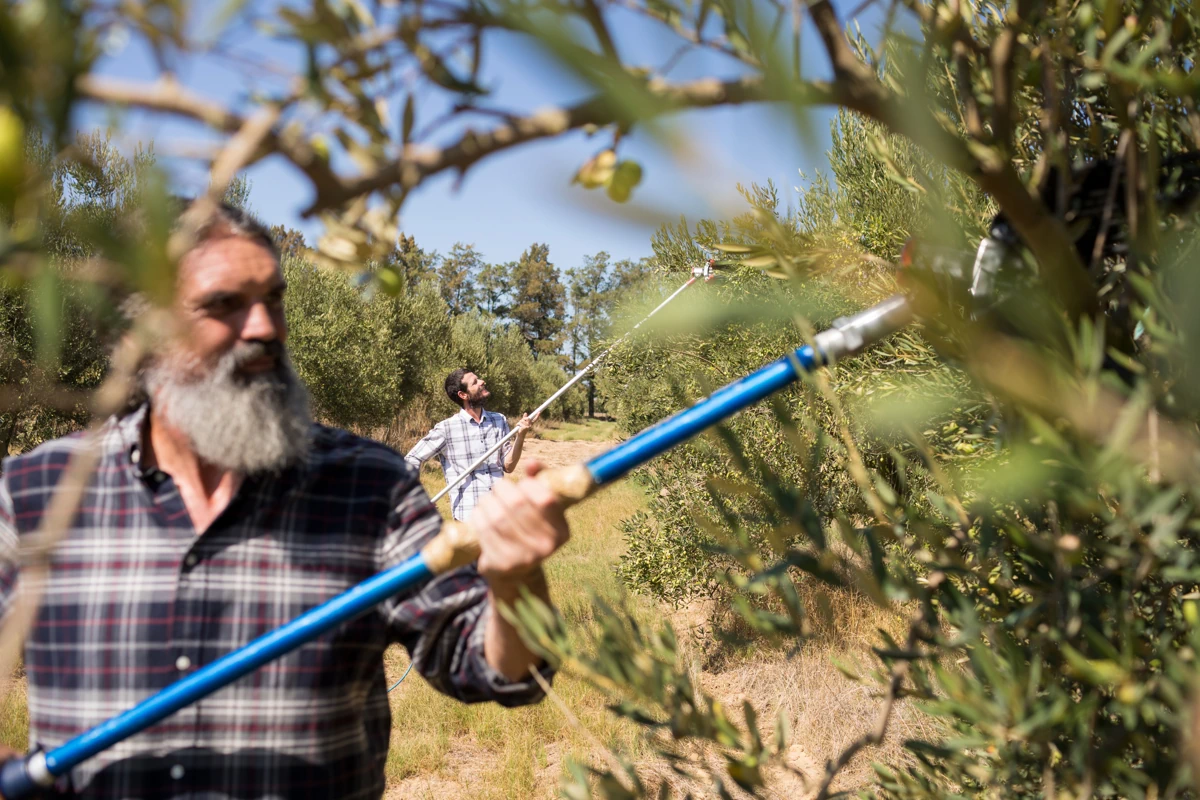 With this tool, several people “brush” the tree from all sides at once, and move on to the next one. Previously, mostly men were harvesting olives, because the weight of the tool was about 4 kilograms, and it must be held at arm’s length for almost the whole day, but with technological progress, the weight has become a little less and many women are also knocking down olives.
With this tool, several people “brush” the tree from all sides at once, and move on to the next one. Previously, mostly men were harvesting olives, because the weight of the tool was about 4 kilograms, and it must be held at arm’s length for almost the whole day, but with technological progress, the weight has become a little less and many women are also knocking down olives.
When farmers move on to harvest olives from the next tree, the others collect nets with knocked-down olives and put them into bags. Thus, the collection continues until dark with breaks for lunch or coffee. An adult tree in a fertile year yields about 40-60 kilograms of fruit. The olive tree yields a good harvest every two years. After harvesting olives in a fertile year, the tree must be “renewed”, all the extra branches are cut off, leaving only “tassels” on several trunks, so that it would be possible to come closer to collect olives.
The collected olives must be brought to the olive oil factory immediately during the day of collection, the longer they lie, the lower the quality of the oil.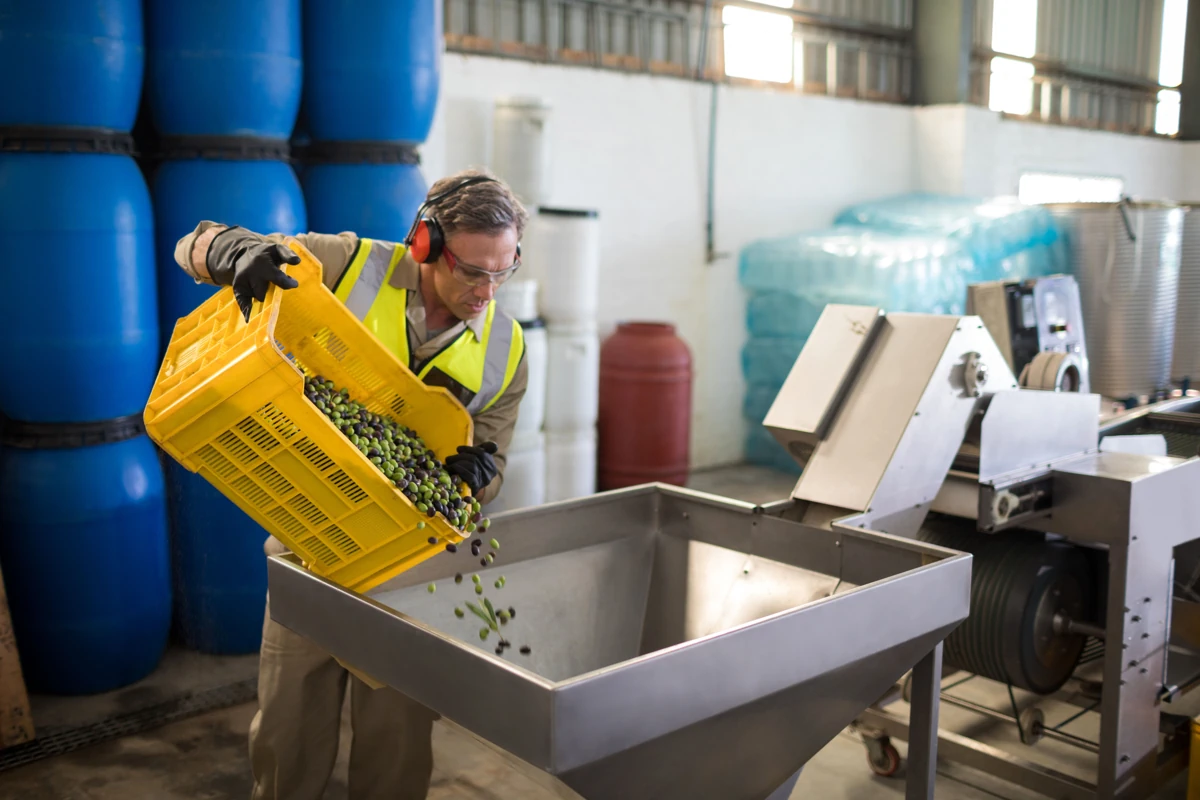 The locals take this process of making olive oil very seriously, but oil is not everywhere pressed according to the standard temperature of no more than 28 degrees, also called as “cold-press”, sometimes the temperature is much higher in order to get more oil. So why would the owners of the factories make the temperature higher? Simple, basically all olive oil factories in Greece take payment with the oil. Locals always buy oil from their neighbours to be sure of its quality.
The locals take this process of making olive oil very seriously, but oil is not everywhere pressed according to the standard temperature of no more than 28 degrees, also called as “cold-press”, sometimes the temperature is much higher in order to get more oil. So why would the owners of the factories make the temperature higher? Simple, basically all olive oil factories in Greece take payment with the oil. Locals always buy oil from their neighbours to be sure of its quality.
So slowly we came to the most intriguing part – the acidity of the oil, what is it. Let’s dive a little into chemistry and theory.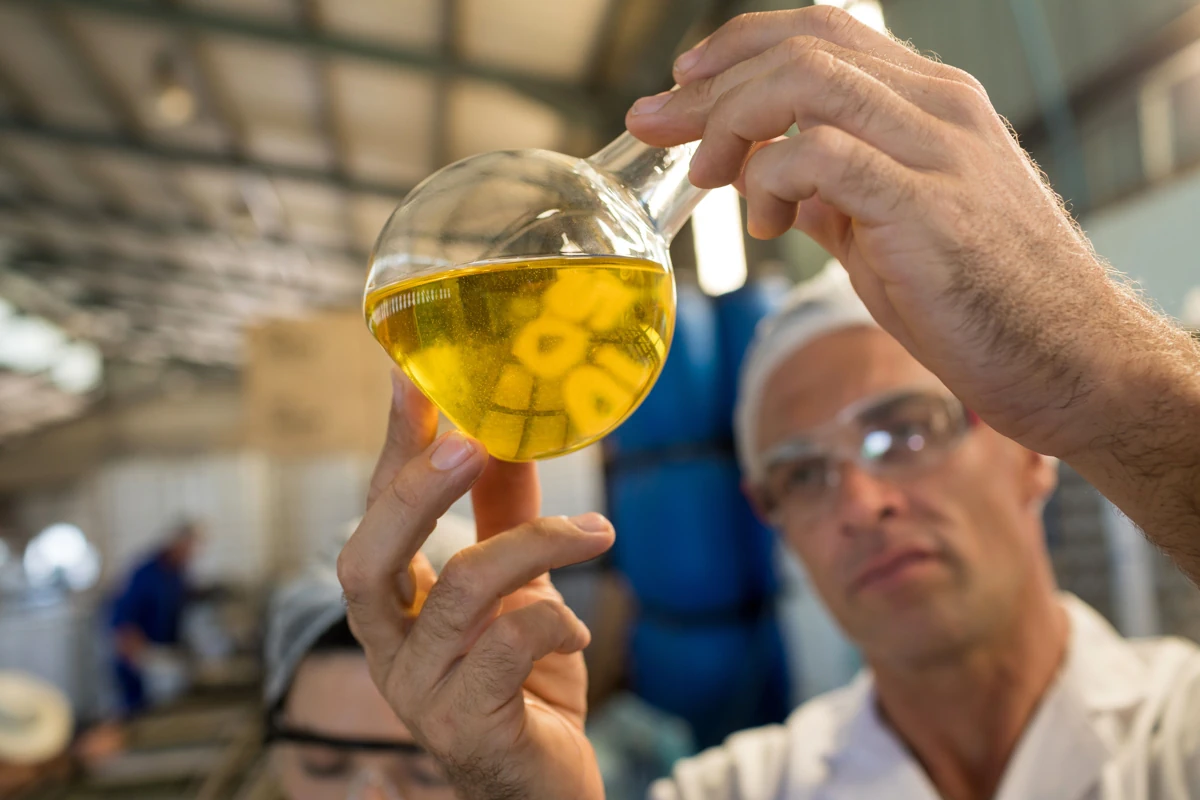 Acidity is one thing, and oxidation is quite another. The value of acidity is related to the condition of the fruits and how they are treated until they get to the factory. Oxidation is related to the amount of oxygen the product comes into contact with after the fruits are crushed and turned into olive pulp, and then with the method of storing the oil.
Acidity is one thing, and oxidation is quite another. The value of acidity is related to the condition of the fruits and how they are treated until they get to the factory. Oxidation is related to the amount of oxygen the product comes into contact with after the fruits are crushed and turned into olive pulp, and then with the method of storing the oil.
Another indicator useful for determining the quality of olive oil is absorption in the ultraviolet spectrum. This measurement provides information about the quality of olive oil and, in particular, the degree of oxidation. Measurements are carried out at two wavelengths – 232 and 270 nm. Primary oxidation products (conjugated peroxides) are absorbed at the first wavelength, and secondary oxidation products (aldehydes, ketones) are absorbed at the second wavelength. The difference (ΔK) in absorption gives information about the degree of oxidation of the oil. The lower the value, the higher the quality of olive oil, and it should not exceed 0.01 for “extra virgin” olive oil.
Other quality indicators are K232, which should not exceed 2.5 and K270 should be less than 0.22. Their values indicate the presence of a large amount of oxidizing substances and falsification.
A very good olive oil must meet at least four of the following six criteria:
Acidity < 0.3
Peroxide number < 8
Polyphenols > 200 mcg/kg
According to the tasting scale , it should have:
Fruitiness > 3.0
Spice > 2.0
Bitterness >2.0
If we calculate the factors determining the quality of oil as a percentage, they will be as follows: 60% – the oil factory, 20% – the degree of fruit ripening, 15% – the variety, various diseases, 5% – the region.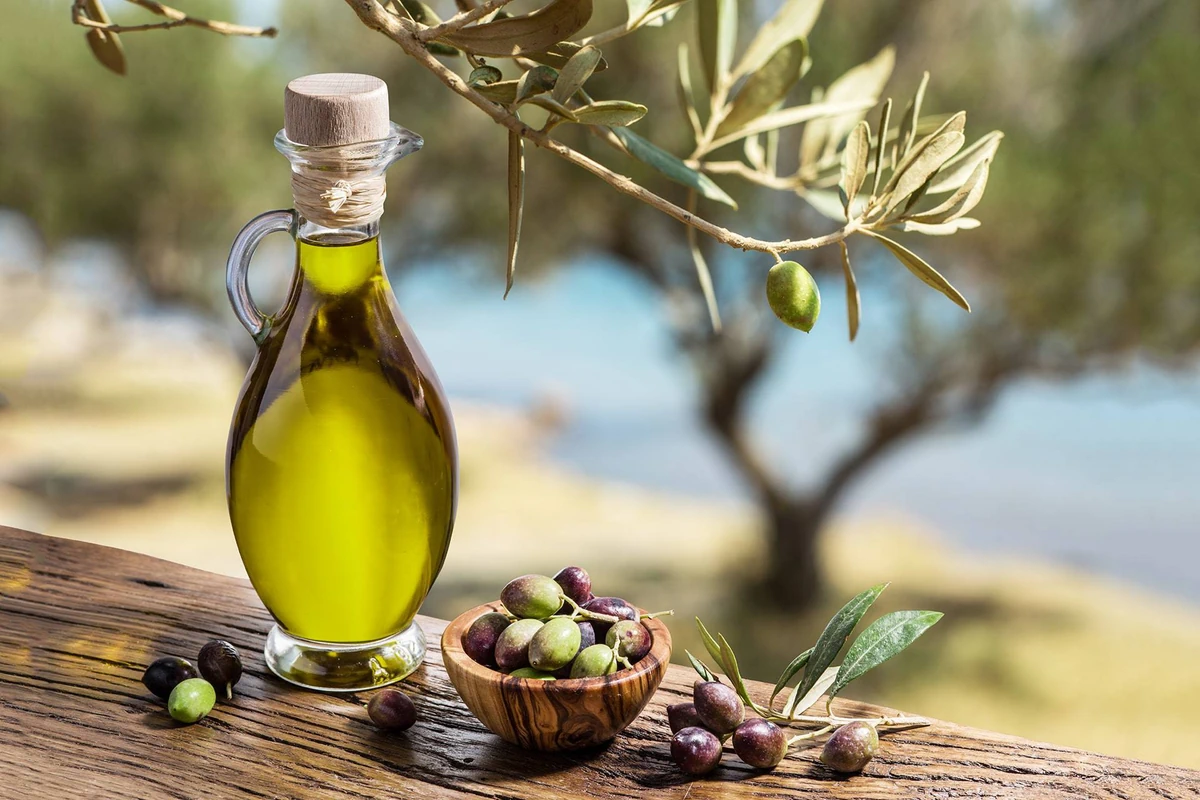 A good oil is immediately visible, the color is dark green, completely transparent, without sediment or any impurities inside. It tastes nice with a grassy smell.
A good oil is immediately visible, the color is dark green, completely transparent, without sediment or any impurities inside. It tastes nice with a grassy smell.
In order for the oil to remain good and tasty for a long time, it must be kept in a glass jar/bottle in a dark and cool place, but not in the fridge. If the oil is in a large container, it is better to pour it into a smaller jar/bottle to avoid contact with air as much as possible.
 So it may seem strange but it all starts with a story. Almost all pieces of land with olive trees are inherited, there have been found olive trees couple thousands years old that still bear fruit even today. Let’s start with sorting the olives by varieties.
So it may seem strange but it all starts with a story. Almost all pieces of land with olive trees are inherited, there have been found olive trees couple thousands years old that still bear fruit even today. Let’s start with sorting the olives by varieties.
There are different varieties of olives that we eat: kalamon, koroneika, androcarpi, vasilakada, strogiloelia and others. They grow on tall trees with storng trunks and wide crowns, here comes the question: how to collect thise olives?
The olives that we eat practically “come” to the table by themselves. They should not be knocked down, because damaged olives can not be marinated. The process of collecting olives has several steps.
 In October, Greeks spread nets with fine weaving under the trees and wait for the olives to start falling, also farmers collect them from the nets from time to time. If the tree is still young and not tall, olives are collected by hands.
In October, Greeks spread nets with fine weaving under the trees and wait for the olives to start falling, also farmers collect them from the nets from time to time. If the tree is still young and not tall, olives are collected by hands.
The next stage is soaking – “xepicrisma”, which literally means the removal of bitterness. The collected olives are carefully sorted, damaged are thrown away, the rest are sent to a container with water for 2-3 weeks, the water must be changed every day. After that, they are poured with marinade for another 2 weeks. This is the most classic cooking recipe, but there are also many others.
 By the way, green olives, brown or black can be harvested from one tree, and the color differs in the degree of ripeness, also depending on this the time of marinating the olives can be different. It’s better to store olives in a dark cabinet, in a jar with olive oil and vinegar, you can add herbs or garlic. Not all olives that we eat are suitable for oil.
By the way, green olives, brown or black can be harvested from one tree, and the color differs in the degree of ripeness, also depending on this the time of marinating the olives can be different. It’s better to store olives in a dark cabinet, in a jar with olive oil and vinegar, you can add herbs or garlic. Not all olives that we eat are suitable for oil.
Now it’s time to talk about the “liquid gold”, the olive oil. If the olive trees whose olives we eat practically do not need any care, then the trees whose fruits are harvested for making olive oil, the care is very necessary. It all starts in early spring, when the trees are blooming, it is necessary to make sure that there is enough moisture, the tree has not been damaged by insect-pests, and the soil is loose enough.
 After blooming, when the fruits have already appeared, it is necessary to spray the trees from insect-pests, otherwise the harvest will be spoiled. It is known that olive trees can bear fruit without additional irrigation, but in some regions there is not enough rain for a good harvest, so it is necessary to additionally irrigate the trees.
After blooming, when the fruits have already appeared, it is necessary to spray the trees from insect-pests, otherwise the harvest will be spoiled. It is known that olive trees can bear fruit without additional irrigation, but in some regions there is not enough rain for a good harvest, so it is necessary to additionally irrigate the trees.
Fruits ripen at different times, depending on the region where the tree grows, on the variety of the tree itself and the amount of moisture. Usually from the beginning of October to the end of December, and often until January, olives are harvested. The highest quality oil is considered to be from unripe green or half purple olives.
Most of families collect olives on their own. Early in the morning, everyone goes to the plantation, usually the oldest member of the family remembers and marks their trees in the garden, since there are no fences and a neighbor’s garden begins right next to the trees. Usually in order to get to your garden, you need to go through the neighbor’s. The first thing to do is to spread nets under the trees, so that no fruit is lost during harvesting. Long three-meter sticks with rotating tips are connected to the generator and the collection begins.
 With this tool, several people “brush” the tree from all sides at once, and move on to the next one. Previously, mostly men were harvesting olives, because the weight of the tool was about 4 kilograms, and it must be held at arm’s length for almost the whole day, but with technological progress, the weight has become a little less and many women are also knocking down olives.
With this tool, several people “brush” the tree from all sides at once, and move on to the next one. Previously, mostly men were harvesting olives, because the weight of the tool was about 4 kilograms, and it must be held at arm’s length for almost the whole day, but with technological progress, the weight has become a little less and many women are also knocking down olives.
When farmers move on to harvest olives from the next tree, the others collect nets with knocked-down olives and put them into bags. Thus, the collection continues until dark with breaks for lunch or coffee. An adult tree in a fertile year yields about 40-60 kilograms of fruit. The olive tree yields a good harvest every two years. After harvesting olives in a fertile year, the tree must be “renewed”, all the extra branches are cut off, leaving only “tassels” on several trunks, so that it would be possible to come closer to collect olives.
The collected olives must be brought to the olive oil factory immediately during the day of collection, the longer they lie, the lower the quality of the oil.
 The locals take this process of making olive oil very seriously, but oil is not everywhere pressed according to the standard temperature of no more than 28 degrees, also called as “cold-press”, sometimes the temperature is much higher in order to get more oil. So why would the owners of the factories make the temperature higher? Simple, basically all olive oil factories in Greece take payment with the oil. Locals always buy oil from their neighbours to be sure of its quality.
The locals take this process of making olive oil very seriously, but oil is not everywhere pressed according to the standard temperature of no more than 28 degrees, also called as “cold-press”, sometimes the temperature is much higher in order to get more oil. So why would the owners of the factories make the temperature higher? Simple, basically all olive oil factories in Greece take payment with the oil. Locals always buy oil from their neighbours to be sure of its quality.
So slowly we came to the most intriguing part – the acidity of the oil, what is it. Let’s dive a little into chemistry and theory.
 Acidity is one thing, and oxidation is quite another. The value of acidity is related to the condition of the fruits and how they are treated until they get to the factory. Oxidation is related to the amount of oxygen the product comes into contact with after the fruits are crushed and turned into olive pulp, and then with the method of storing the oil.
Acidity is one thing, and oxidation is quite another. The value of acidity is related to the condition of the fruits and how they are treated until they get to the factory. Oxidation is related to the amount of oxygen the product comes into contact with after the fruits are crushed and turned into olive pulp, and then with the method of storing the oil.
Another indicator useful for determining the quality of olive oil is absorption in the ultraviolet spectrum. This measurement provides information about the quality of olive oil and, in particular, the degree of oxidation. Measurements are carried out at two wavelengths – 232 and 270 nm. Primary oxidation products (conjugated peroxides) are absorbed at the first wavelength, and secondary oxidation products (aldehydes, ketones) are absorbed at the second wavelength. The difference (ΔK) in absorption gives information about the degree of oxidation of the oil. The lower the value, the higher the quality of olive oil, and it should not exceed 0.01 for “extra virgin” olive oil.
Other quality indicators are K232, which should not exceed 2.5 and K270 should be less than 0.22. Their values indicate the presence of a large amount of oxidizing substances and falsification.
A very good olive oil must meet at least four of the following six criteria:
Acidity < 0.3
Peroxide number < 8
Polyphenols > 200 mcg/kg
According to the tasting scale , it should have:
Fruitiness > 3.0
Spice > 2.0
Bitterness >2.0
If we calculate the factors determining the quality of oil as a percentage, they will be as follows: 60% – the oil factory, 20% – the degree of fruit ripening, 15% – the variety, various diseases, 5% – the region.
 A good oil is immediately visible, the color is dark green, completely transparent, without sediment or any impurities inside. It tastes nice with a grassy smell.
A good oil is immediately visible, the color is dark green, completely transparent, without sediment or any impurities inside. It tastes nice with a grassy smell.
In order for the oil to remain good and tasty for a long time, it must be kept in a glass jar/bottle in a dark and cool place, but not in the fridge. If the oil is in a large container, it is better to pour it into a smaller jar/bottle to avoid contact with air as much as possible.
-

Discover the Enchanting Flavors of Santorini Wines
Enjoy Santorini’s volcanic wines – a taste of paradise in Greece.
-

Discover the Stunning Beaches of Corfu
Let’s dive into the top beaches of Corfu and explore the beauty they have to offer!
-

3 Days in Athens
Planning a trip to Athens? In this post, you will find out how to spend three days in Athens with a detailed three-day itinerary.